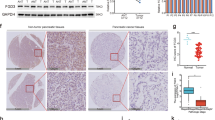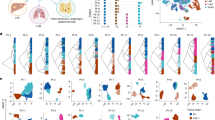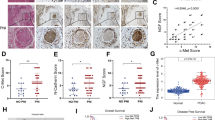Abstract
Because of the highly aggressive behaviour, i.e. invasive, disseminative and metastatic properties, the outcome for patients with pancreatic cancer is morbid. A better understanding and interference with the malignant behaviour of pancreatic cancer may provide new directions for treatment. We report here the induction of highly motile and invasive properties in human pancreatic cancer cells by hepatocyte growth factor (HGF) and blockage of these properties by NK4, a newly identified antagonist for HGF. In all of eight human pancreatic cancer cell lines we used (AsPC-1, BxPC-3, H-48N, KP-1N, KP-2, KP-3, MIA PaCa-2 and SUIT-2 cells), the c-Met/HGF receptor was expressed at varying levels. Although weak mitogenic activity of HGF was seen only in SUIT-2 and KP-3 cells, HGF strongly stimulated migration and invasion of these pancreatic cancer cells, except for BxPC-3 and MIA PaCa-2 cells. In contrast, migration and invasion potently induced by HGF in KP-1N, KP-3 and SUIT-2 cells were inhibited by NK4. The invasion of SUIT-2 cells was also potently stimulated with the influence of cocultured pancreatic fibroblasts and by ascitic fluid obtained after pancreatic cancer resection, however, invasiveness of the cancer cells in such conditions was practically abolished by NK4. Consistently, the ascitic fluid in patients who had undergone pancreatic cancer surgery contained high levels of HGF. These findings mean that HGF is probably involved in invasion, dissemination, and metastasis of pancreatic cancer, particularly through tumour-stromal interaction and after resection of the pancreatic cancer. NK4, an effective antagonist of HGF, may prove to have the potential for anti-invasion/metastasis. © 2001 Cancer Research Campaign
Similar content being viewed by others
Article PDF
Change history
16 November 2011
This paper was modified 12 months after initial publication to switch to Creative Commons licence terms, as noted at publication
References
Bogden AE, Moreau JP and Eden PA (1997) Proliferative response of human and animal tumours to surgical wounding of normal tissues: onset, duration and inhibition. Br J Cancer 75: 1021–1027
Bramhall SR, Allum WH, Jones AG, Allwood A, Cummins C and Neoptolemos JP (1995) Treatment and survival in 13 560 patients with pancreatic cancer, and incidence of the disease, in the West Midlands: an epidemiological study. Br J Surg 82: 111–115
Bussolino F, Di Renzo MF, Ziche M, Bocchietto E, Olivero M, Naldini L, Gaudino G, Tamagnone L, Coffer A and Comoglio PM (1992) Hepatocyte growth factor is a potent angiogenic factor which stimulates endothelial cell motility and growth. J Cell Biol 119: 629–641
Camps JL, Chang S, Hsu TC, Freeman MR, Hong S, Zhau HE, von Eschenbach AC and Chung LW (1990) Fibroblast-mediated acceleration of human epithelial tumor growth in vivo. Proc Natl Acad Sci USA 87: 75–79
Date K, Matsumoto K, Shimura H, Tanaka M and Nakamura T (1997) HGF/NK4 is a specific antagonist for pleiotrophic actions of hepatocyte growth factor. FEBS Lett 420: 1–6
Date K, Matsumoto K, Kuba K, Shimura H, Tanaka M and Nakamura T (1998) Inhibition of tumor growth and invasion by a four-kringle antagonist (HGF/NK4) for hepatocyte growth factor. Oncogene 17: 3045–3054
Di Renzo MF, Poulsom R, Olivero M, Comoglio PM and Lemoine NR (1995) Expression of the Met/hepatocyte growth factor receptor in human pancreatic cancer. Cancer Res 55: 1129–1138
Eagles G, Warn A, Ball RY, Baillie-Johnson H, Arakaki N, Daikuhara Y and Warn RM (1996) Hepatocyte growth factor/scatter factor is present in most pleural effusion fluids from cancer patients. Br J Cancer 73: 377–381
Ebert M, Yokoyama M, Friess H, Buchler MW and Korc M (1994) Coexpression of the c-met proto-oncogene and hepatocyte growth factor in human pancreatic cancer. Cancer Res 54: 5775–5778
Furukawa T, Duguid WP, Kobari M, Matsuno S and Tsao MS (1995) Hepatocyte growth factor and Met receptor expression in human pancreatic carcinogenesis. Am J Pathol 147: 889–895
Gherardi E, Gray J, Stoker M, Perryman M and Furlong R (1989) Purification of scatter factor, a fibroblast-derived basic protein that modulates epithelial interaction and movement. Proc Natl Acad Sci USA 86: 5844–5848
Grey AM, Schor AM, Rushton G, Ellis I and Scholr SL (1989) Purification of the migration stimulating factor produced by fetal and breast cancer patient fibroblasts. Proc Natl Acad Sci USA 86: 2438–2442
Hiscox S, Parr C, Nakamura T, Matsumoto K, Mansel RE and Jiang WG (2000) Inhibition of HGF/SF-induced breast cancer cell motility and invasion by the HGF/SF variant, NK4. Breast Cancer Res & Treat 1627: 1–10
Inoue T, Chung YS, Yashiro M, Nishimura S, Hasuma T, Otani S and Sowa M (1997) Transforming growth factor-beta and hepatocyte growth factor produced by gastric fibroblasts stimulates the invasiveness of scirrhous gastric cancer cells. Jpn J Cancer Res 88: 152–159
Jeffers M, Rong S and Vande Woude GF (1996) Enhanced tumorigenicity and invasion-metastasis by hepatocyte growth factor/scatter factor-met signalling in human cells concomitant with induction of the urokinase proteolysis network. Mol Cell Biol 16: 1115–1125
Jiang WG, Lloyds D, Puntis MCA, Nakamura T and Hallet MB (1993) Regulation of spreading and growth of colon cancer cells by hepatocyte growth factor. Clin Exp Metastasis 11: 235–242
Jiang WG, Hiscox S, Nakamura T, Hallett MB, Puntis MCA and Mansel RE (1996) Hepatocyte growth factor/scatter factor induces tyrosine phosphorylation of focal adhesin kinase (FAK) and paxillin and enhances cell-matrix interactions. Oncology Rep 3: 819–823
Jiang WG, Hiscox S, Matsumoto K and Nakamura T (1999) Hepatocyte growth factor/scatter factor, its molecular, cellular, and clinical implications in cancer. Crit Rev Oncol Hematol 29: 209–248
Kadono Y, Shibahara K, Namiki M, Watanabe Y, Seiki M and Sato H (1998) Membrane type-matrix metalloproteinase is involved in the formation of hepatocyte growth factor/scatter factor-induced branching tubules in Mardin-Darby canine kidney epithelial cells. Biochem Biophys Res Commun 251: 681–687
Kimura F, Miyazaki M, Suwa T, Kakizaki S, Itoh H, Kaiho T, Ambiru S, Shimizu H and Togawa A (1996) Increased levels of human hepatocyte growth factor in serum and peritoneal fluid after partial hepatectomy. Am J Gastroenterol 91: 116–121
Kodama M, Kodama T, Nishi Y and Totani R (1992) Does surgical stress cause tumor metastasis?. Anticancer Res 12: 1603–1616
Kuba K, Matsumoto K, Date K, Shimura H, Tanaka M and Nakamura T (2000) HGF/NK4, a four-kringle antagonist of hepatocyte growth factor, is an angiogenesis inhibitor that suppresses tumor growth and metastasis in mice. Cancer Res 60: 6737–6743
Matsumoto K, Matsumoto K, Nakamura T and Kramer RH (1994) Hepatocyte growth factor/scatter factor induces tyrosine phosphorylation of focal adhesion kinase (p125FAK) and promotes migration and invasion by oral squamous cell carcinoma cells. J Biol Chem 269: 31807–31813
Matsumoto K, Date K, Shimura H and Nakamura T (1996) Acquisition of invasive phenotype in gallbladder cancer cells via mutual interaction of stromal fibroblasts and cancer cells as mediated by hepatocyte growth factor. Jpn J Cancer Res 87: 702–710
Matsumoto K and Nakamura T (1997) Hepatocyte growth factor as a tissue organizer for organogenesis and regeneration. Biochem Biophys Res Commun 239: 639–644
Miyazawa K, Tsubouchi H, Naka D, Takahashi K, Okigaki M, Gohda E, Daikuhara Y and Kitamura N (1989) Molecular cloning and sequence analysis of cDNA for human hepatocyte growth factor. Biochem Biophys Res Commun 163: 967–973
Morishita R, Nakamura S, Hayashi S, Taniyama Y, Moriguchi A, Nagano T, Taiji M, Noguchi H, Takeshita S, Matsumoto K, Nakamura T, Higaki J and Ogihara T (1999) Therapeutic angiogenesis induced by human recombinant hepatocyte growth factor in rabbit hind limb ischemia model as cytokine supplement therapy. Hypertension 33: 1379–1384
Nabeshima K, Shimano Y, Inoue T, Itoh H, Kataoka H and Koono M (1998) Hepatocyte growth factor/scatter factor induces not only scattering but also cohort migration of human colorectal-adenocarcinoma cells. Int J Cancer 78: 750–759
Nakamura T, Nawa K and Ichihara A (1984) Partial purification and characterization of hepatocyte growth factor from serum of hepatectomized rats. Biochem Biophys Res Commun 122: 1450–1459
Nakamura T, Nishizawa T, Hagiya M, Seki T, Shimonishi M, Sugimura A, Tashiro K and Shimizu S (1989) Molecular cloning and expression of human hepatocyte growth factor. Nature 342: 440–443
Nakamura T, Matsumoto Kiritoshi A, Tano Y and Nakamura T (1997) Induction of hepatocyte growth factor in fibroblasts by tumor-derived factors affects invasive growth of tumor cells: in vitro analysis of tumor–stromal interactions. Cancer Res 57: 3305–3313
Niederhuber JE, Brennan MF and Menck HR (1995) The National Cancer Data Base report on pancreatic cancer. Cancer 76: 1671–1677
Paciucci R, Vila MR, Adell T, Diaz VM, Tora M, Nakamura T and Real FX (1998) Activation of the urokinase plasminogen activator/ urokinase plasminogen activator receptor system and redistribution of E-cadherin are associated with hepatocyte growth factor-induced motility of pancreas tumor cells overexpressing Met. Am J Pathol 153: 201–212
Parr C, Hiscox S, Nakamura T, Matsumoto K and Jiang WG (2000) NK4, a new HGF/SF variant, is an antagonist to the influence of HGF/SF on the motility and invasion of colon cancer cells. Int J Cancer 85: 563–570
Pepper MS, Matsumoto K, Nakamura T and Montesano R (1992) Hepatocyte growth factor increases urokinase-type plasminogen activator (u-PA) and uPA receptor expression in Madin-Darby canine kidney epithelial cells. J Biol Chem 267: 20493–20496
Poston GJ, Gillespie J and Guillou PJ (1991) Biology of pancreatic cancer. Gut 32: 800–812
Rosen EM, Joseph A, Jin L, Rockwell S, Elias JA, Knesel J, Wines J, McClellan J, Kluger MJ, Goldberg ID and Zitnik R (1994) Regulation of scatter factor production via a soluble inducing factor. J Cell Biol 127: 225–234
Rosen EM, Laterra J, Joseph A, Jin L, Fuchs A, Way D, Witte M, Weinand M and Goldberg ID (1996) Scatter factor expression and regulation in human glial tumors. Int J Cancer 67: 248–255
Rosenthal EL, Johnson TM, Allen ED, Apel IJ, Punturieri A and Weiss SJ (1998) Role of the plasminogen activator and matrix metalloproteinase system in epidermal growth factor-and scatter factor-stimulated invasion of carcinoma cells. Cancer Res 58: 5221–5230
Seki T, Ihara I, Sugimura A, Shimonishi M, Nishizawa T, Asami O, Hagiya M, Nakamura T and Shimizu S (1990) Isolation and expression of cDNA for different forms of hepatocyte growth factor from human leukocyte. Biochem Biophys Res Commun 172: 321–327
Seslar SP, Nakamura T and Byers SW (1993) Regulation of fibroblast hepatocyte growth factor/scatter factor expression by human breast carcinoma cell lines and peptide growth factors. Cancer Res 53: 1233–1238
Shibamoto S, Hayakawa M, Takeuchi K, Hori T, Oku N, Miyazawa K, Kitamura N, Takeichi M and Ito F (1994) Tyrosine phosphorylation of β-catenin and plakoglobin enhanced by hepatocyte growth factor and epidermal growth factor in human carcinoma cells. Cell Adhes Commun 1: 295–305
Sperti C, Pasquali C, Piccoli A and Pedrazzoli S (1997) Recurrence after resection for ductal adenocarcinoma of the pancreas. World J Surg 21: 195–200
Tannapfel A, Yasui W, Yokozaki H, Wittekind C and Tahara E (1994) Effect of hepatocyte growth factor on the expression of E- and P-cadherin in gastric carcinoma cell lines. Virchows Arch 425: 139–144
Uchiyama A, Morisaki T, Beppu K, Kojima M, Nakatsuka A, Mizumoto K, Matsumoto K, Nakamura T and Tanaka M (1999) Hepatocyte growth factor and invasion-stimulatory activity are induced in pleural fluid by surgery in lung cancer patients. Br J Cancer 81: 721–726
Van Belle E, Witzenbichler B, Chen D, Silver M, Chang L, Schwall R and Isner JM (1998) Potentiated angiogenic effect of scatter factor/ hepatocyte growth factor via induction of vascular endothelial growth factor: the case for paracrine amplification of angiogenesis. Circulation 97: 381–390
Vila MR, Nakamura T and Real FX (1995) Hepatocyte growth factor is a potent mitogen for normal human pancreas cells in vitro. Lab Invest 73: 409–453
Warshaw AL and Fernandez-del Castillo C (1992) Pancreatic carcinoma. N Engl J Med 326: 455–465
Watabe M, Matsumoto K, Nakamura T and Takeichi M (1993) Cooperative action of hepatocyte growth factor and anti-cadherin antibodies on the scattering of keratinocytes. Cell Struct Funct 18: 117–124
Weidner KM, Behrens J, Vanderkerckhove J and Birchmeier W (1990) Scatter factor: molecular characteristics and effect on the invasiveness ofepithelial cells. J Cell Biol 111: 2097–2108
Zarnegar R and Michalopoulos GK (1995) The many faces of hepatocyte growth factor: from hepatopoiesis to hematopoiesis. J Cell Biol 129: 1177–1180
Author information
Authors and Affiliations
Corresponding author
Rights and permissions
From twelve months after its original publication, this work is licensed under the Creative Commons Attribution-NonCommercial-Share Alike 3.0 Unported License. To view a copy of this license, visit http://creativecommons.org/licenses/by-nc-sa/3.0/
About this article
Cite this article
Maehara, N., Matsumoto, K., Kuba, K. et al. NK4, a four-kringle antagonist of HGF, inhibits spreading and invasion of human pancreatic cancer cells. Br J Cancer 84, 864–873 (2001). https://doi.org/10.1054/bjoc.2000.1682
Received:
Revised:
Accepted:
Published:
Issue date:
DOI: https://doi.org/10.1054/bjoc.2000.1682
Keywords
This article is cited by
-
Pancreatic ductal adenocarcinoma: tumor microenvironment and problems in the development of novel therapeutic strategies
Clinical and Experimental Medicine (2022)
-
Imidazopyridine hydrazone derivatives exert antiproliferative effect on lung and pancreatic cancer cells and potentially inhibit receptor tyrosine kinases including c-Met
Scientific Reports (2021)
-
Cancer-Associated Fibroblasts Enhance Survival and Progression of the Aggressive Pancreatic Tumor Via FGF-2 and CXCL8
Cancer Microenvironment (2019)
-
PAK4 interacts with p85 alpha: implications for pancreatic cancer cell migration
Scientific Reports (2017)
-
Process of hepatic metastasis from pancreatic cancer: biology with clinical significance
Journal of Cancer Research and Clinical Oncology (2016)



